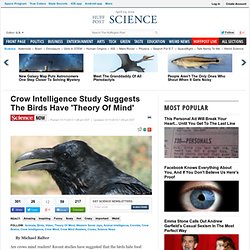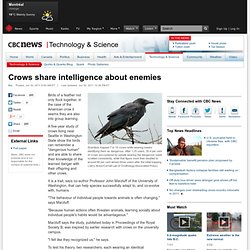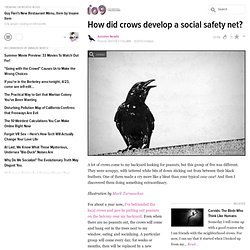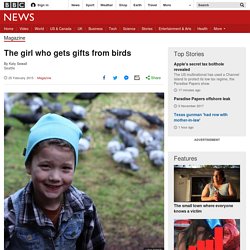

Untitled. Evidence suggesting that desire-state attribution may govern food sharing in Eurasian jays. Crow Intelligence Study Suggests The Birds Have 'Theory Of Mind' By Michael Balter Are crows mind readers?

Recent studies have suggested that the birds hide food because they think others will steal it -- a complex intuition that has been seen in only a select few creatures. Some critics have suggested that the birds might simply be stressed out, but new research reveals that crows may be gifted after all. Cracks first began forming in the crow mind-reading hypothesis last year. One member of a research team from the University of Groningen in the Netherlands spent 7 months in bird cognition expert Nicola Clayton's University of Cambridge lab in the United Kingdom studying Western scrub jays, a member of the crow family that is often used for these studies.
In the new study, Clayton and her Cambridge graduate student James Thom decided to test the stress hypothesis. Then came the stress test. Amanda Seed, an animal cognition researcher at the University of St. ScienceNOW, the daily online news service of the journal Science Also on HuffPost: Crows share intelligence about enemies - Technology & Science. Scientists trapped 7 to 15 crows while wearing masks identifying them as dangerous.

After 1.25 years, 30.4 per cent of crows encountered by people wearing the dangerous mask scolded consistently, while that figure more than doubled to around 66 per cent almost three years after the initial trapping. (Jerry Acton/Cornell Lab of Ornithology/Associated Press) Birds of a feather not only flock together, in the case of the American crow it seems they are also into group learning. A five-year study of crows living near Seattle in Washington State show the birds can remember a "dangerous human" and are able to share their knowledge of the learned danger with their offspring and other crows.
It is a trait, says co-author Professor John Marzluff of the University of Washington, that can help species successfully adapt to, and co-evolve with, humans. "The behaviour of individual people towards animals is often changing," says Marzluff. "I felt like they recognized us," he says. Consistent scolding. How did crows develop a social safety net? I have to share my Raven story.

Here in the Pacific Northwest Crows are common. We have Ravens too, some places, but though they look similar they are far different creatures. For one thing, Ravens are generally solitary while Crows tend to socialize and group. Sometimes out in the woods you'll hear the croak of a Raven (Ravens croak, not caw) and look up to see it flying overhead. Occasionally you'll see a pair, which are probably a breeding pair. So last spring I was outside the shop where I work and noticed what I thought was a murder of Crows sitting on the garbage dumpster. Social cognition by food-caching corvids. The western scrub-jay as a natural psychologist. Cooperative hunting in Brown-Necked Raven (Corvus rufficollis) on Egyptian Mastigure (Uromastyx aegyptius) Seattle Neighbors Are Seriously Pissed About Those Crows That Bring Gifts to an 8-year-old Girl. The girl who gets gifts from birds. Image copyright Lisa Mann Lots of people love the birds in their garden, but it's rare for that affection to be reciprocated.

One young girl in Seattle is luckier than most. She feeds the crows in her garden - and they bring her gifts in return. Eight-year-old Gabi Mann sets a bead storage container on the dining room table, and clicks the lid open. This is her most precious collection. "You may take a few close looks," she says, "but don't touch. " Inside the box are rows of small objects in clear plastic bags. Each item is individually wrapped and categorised. There's a miniature silver ball, a black button, a blue paper clip, a yellow bead, a faded black piece of foam, a blue Lego piece, and the list goes on. Image copyright Katy Sewall She didn't gather this collection. She holds up a pearl coloured heart.
Gabi's relationship with the neighbourhood crows began accidentally in 2011. As she got older, she rewarded their attention, by sharing her packed lunch on the way to the bus stop.